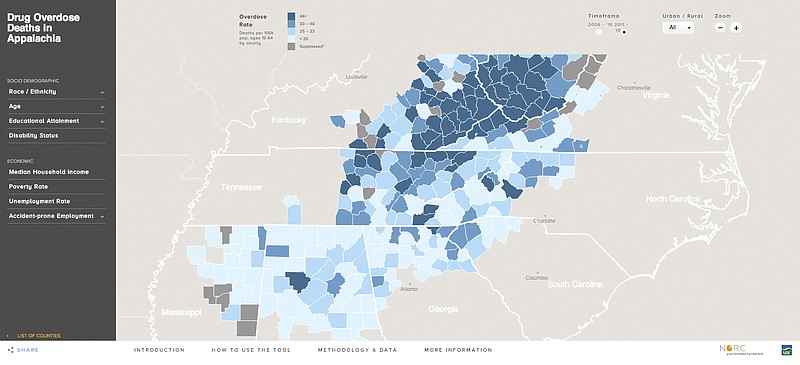Online
To view the interactive map, visit overdosemappingtool.norc.org.
Overdose mortality
Deaths per 100,000 people ages 15-64, by countyTENNESSEECoffee: 28.8Bledsoe: 19.9Bradley: 28.7Franklin: 36.3Grundy: 45.3Hamilton: 23.5Marion: 34.4Meigs; 34.6McMinn: 36.9Polk: 27.9Rhea: 30.0Sequatchie: 32.6GEORGIACatoosa: 27.3Chattooga:Dade: 16.3Gordon: 19.1Murray: 44.3Walker: 24.7Whitfield: 20.2ALABAMADeKalb: 28.8Jackson: 16.4Source: National Opinion Research Center
By the numbers
› Highest rate in Tennessee: Clay County, 72.3› Highest rate in Georgia: Towns County, 48.9› Highest rate in Alabama: Walker County, 58.1› Lowest rate in Tennessee: Bledsoe County, 19.9› Lowest rate in Georgia: Habersham County, 8.7› Lowest rate in Alabama: Elmore County, 7.9Note: This represents totals for those states represented in study, measuring the number of deaths per 100,000 people ages 15-64Source: National Opinion Research Center
A new interactive map released this week by an independent social research organization aims to illustrate the scale of the opioid epidemic in Appalachia, a region that has suffered a disproportionate number of overdoses over the last decade.
The Appalachian Overdose Mapping Tool, released by the National Opinion Research Center at the University of Chicago and the Appalachian Regional Commission, integrates overdose mortality rates with local, socioeconomic data to paint a picture of the situation in 420 counties.
The area of focus in the map is a large band of territory stretching through 13 states from northern Mississippi to the southern border of New York. Researchers said residents in the defined region are 55 percent more likely to die from a drug overdose than other Americans.
"The information we provide goes well beyond demonstrating the impact of opioid abuse in the Appalachian Region," said Michael Meit, co-director of the NORC Walsh Center for Rural Health Analysis. "We hope it will help policymakers and community leaders develop an informed response to the challenges they face by revealing underlying, systemic factors that also need to be addressed."
With 23.5 deaths per 100,000 residents from 2011-2015, Hamilton County has a relatively low overdose mortality rate compared to the host of other counties covered in the study and has the second-lowest mortality rate of counties studied in East Tennessee. The lowest rate in Tennessee is Bledsoe County at 19.9; the highest is Clay County at 72.3.
The tool provides detailed information on the counties covered, including each county's demographic composition. Filters can be toggled on and off to show correlations between overdose mortality rates and factors such as unemployment, poverty, disability and age.
For example, nearly 20 percent of those who have died from an overdose in Hamilton County over the period covered in the study were black, a rate typically seen further to the south in a band stretching through the middle of Mississippi, Alabama and Georgia.
The map also shows that 28.7 percent of overdose deaths in Hamilton County have come from residents who have at least a bachelor's degree, a rate that's six percentage points higher than the rest of Appalachia.
"While this tool looks at overdose deaths, we would expect to see similar patterns related to any number of health and social issues such as violence, heart disease, suicide, and more," Meit said. "We can look at any health outcome and overlay demographic and socioeconomic factors to show important issues that may underlie and explain how the conditions play out at the community level."
The organizations that put together the tool noted several larger takeaways from the map, including the fact that in Central Appalachia counties with the highest rates of overdose are often the same counties with the highest rates of people on disability and the lowest rates of educational attainment.
Toward the northern and southern ends of the region, the highest overdose rates are in urban counties, and although Central Appalachia remains the most highly affected subregion, others are experiencing increasing mortality rates.
"The Appalachian Region has been taking a disproportionate hit in overdose deaths in relation to the rest of the country," said ARC executive director Scott Hamilton. "This tool puts overdose statistics in socioeconomic context, which can be valuable to communities developing comprehensive strategies to address the epidemic."
Contact staff writer Emmett Gienapp at egienapp@timesfreepress.com or 423-757-6731. Follow him on Twitter @emmettgienapp.
